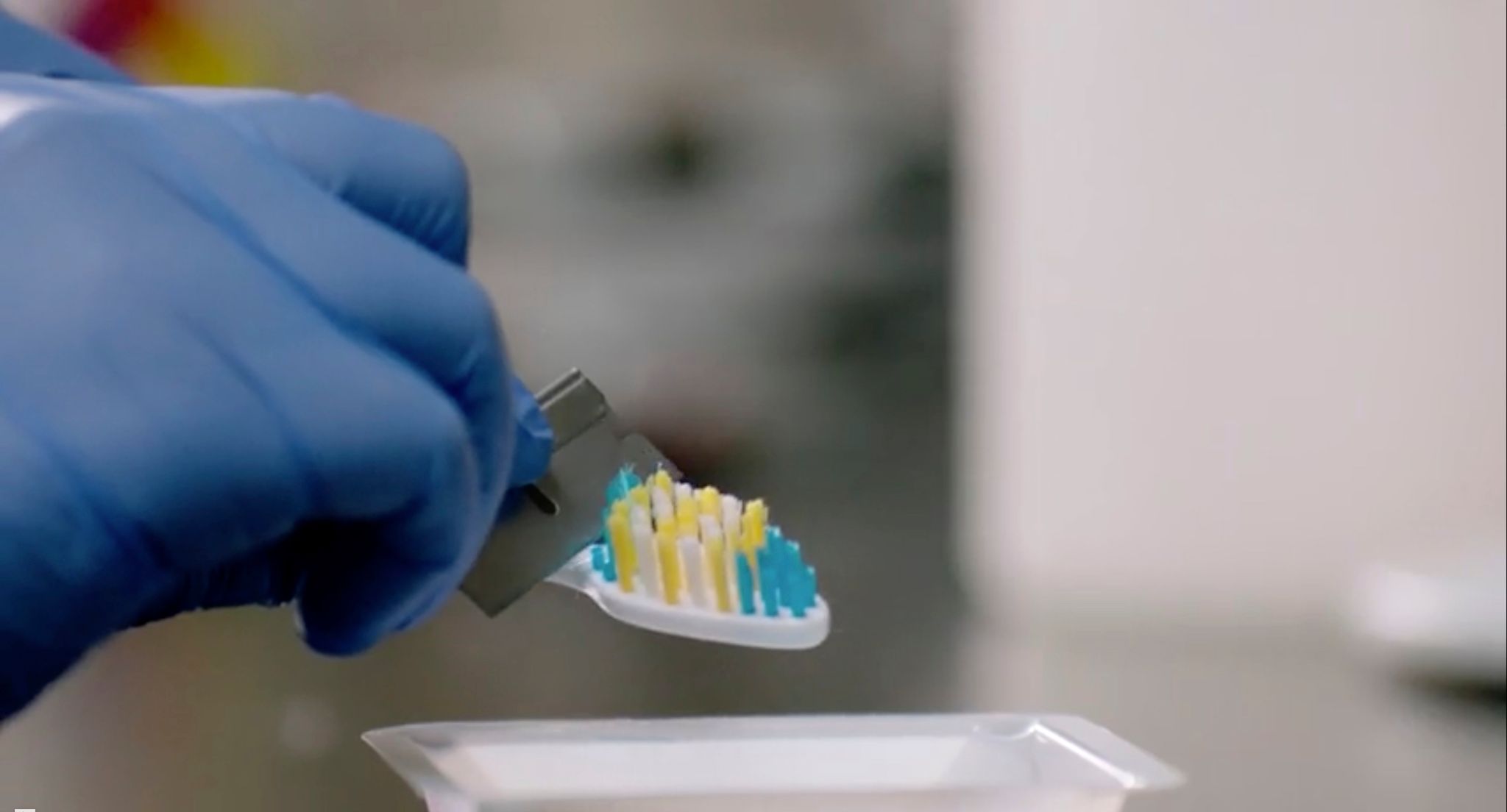Northwestern Study Indicates Your Toothbrush Reflects You, Not Your Toilet
Research shows microbes on your toothbrush match microbes inside your mouth no matter where toothbrush is stored.
A researcher removes bristles from a toothbrush for testing. Photo courtesy of Northwestern Now.

A newly published study provides some good news in regards to toothbrushes and good oral hygiene habits.
Northwestern University (NU) researchers found people with better oral hygiene, who regularly flossed and used mouthwash, had toothbrushes with less diverse microbial communities. The study also appears to lessen concerns that flushing a toilet might generate a cloud of aerosol particles that could contaminate a toothbrush.
The good news from the research says the bacteria living on your toothbrush reflect your mouth – not your toilet.
After studying microbial communities living on bristles from used toothbrushes, the NU researchers found those communities matched microbes commonly found inside the mouth and on skin. This was true no matter where the toothbrushes had been stored, including shielded behind a closed medicine cabinet door or out in the open on the edge of a sink.
The study’s senior author, Erica Hartmann, was inspired to conduct the research after hearing concerns that flushing a toilet might generate a cloud of aerosol particles. She and her team affectionately called their study “Operation Pottymouth.”
“I’m not saying that you can’t get toilet aerosols on your toothbrush when you flush the toilet,” Hartmann says in a press release. “But, based on what we saw in our study, the overwhelming majority of microbes on your toothbrush probably came from your mouth.”
The study is being published Feb. 1 in the journal Microbiome.
Hartmann is an assistant professor of environmental engineering at Northwestern’s McCormick School of Engineering. Ryan Blaustein, a former postdoctoral fellow in Hartmann’s lab, was the paper’s first author. Blaustein is now a postdoctoral fellow at the National Institutes of Health (NIH).
Collecting Samples
To obtain toothbrushes for the study, Hartmann’s team launched the Toothbrush Microbiome Project, which asked people to mail in their used toothbrushes along with corresponding metadata. Hartmann’s team then extracted DNA from the bristles to examine the microbial communities found there. They compared these communities to those outlined by the Human Microbiome Project, an NIH initiative that identified and catalogued microbial flora from different areas of the human body.
“Many people contributed samples to the Human Microbiome Project, so we have a general idea of what the human microbiome looks like,” Blaustein said. “We found that the microbes on toothbrushes have a lot in common with the mouth and skin and very little in common with the human gut.”
“Your mouth and your gut are not separate islands,” Hartmann added. “There are some microbes that we find both in the human gut and mouth, and those microbes are found on toothbrushes. But, again, those are probably coming from your mouth.”
Clean Mouth, Clean Toothbrush
During the research, Hartmann’s team examined how many different types of microbes lived on the toothbrushes. They found people with better oral hygiene, who regularly flossed and used mouthwash, had toothbrushes with less diverse microbial communities.
“If you practice good oral hygiene, then your toothbrush also will be relatively clean,” Hartmann said. “But it’s a small difference. It’s not like people who regularly floss, brush and use mouthwash have no microbes and those who don’t have tons. There’s just a bit less diversity on toothbrushes from people who do all those things.”
The researchers also found that microbes from toothbrushes of people with better oral hygiene had slightly more antimicrobial-resistance genes. Hartmann said microbes with these genes did not match the human body and were likely from air or dust in the bathroom.
Hartmann stresses that there’s no need to be alarmed by microbes living on your toothbrush. Unless your dentist recommends otherwise, people should not reach for antimicrobial toothpastes and toothbrushes.
“By using antimicrobials, you aren’t just getting rid of microbes,” Hartmann said. “You are pushing the surviving microbes toward antimicrobial resistance. In general, for most people, regular toothpaste is sufficient.”
The study, “Toothbrush microbiomes feature a meeting ground for human oral and environmental microbiota,” was supported by the Searle Leadership Fund, the NUSeq Core Facility Illumina Pilot Program and the National Institutes of Health (award number TL1R001423).